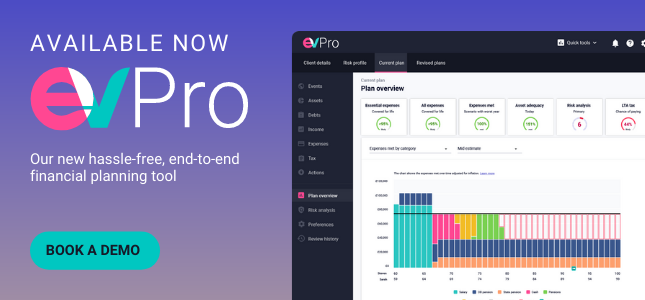Modernising Risk Profiling: Embracing the Use of Risk Profiling Tools

The risk profiling process is in desperate need of a shake-up. We appreciate it’s a bold statement, but one with plausible merit. Given questionnaires lay the foundation for determining a client’s attitude to risk and ability to bear the loss, such tools must ask the right questions.
Why risk profiling needs to modernise
Investors face a fresh set of risks when transitioning from accumulating retirement funds to drawing an income. Failure to accurately assess these risks’ potential impact runs the risks of clients draining their retirement pots too soon.
We’re not the only ones raising concerns about the potential impact on drawdown clients. The Financial Conduct Authority’s (FCA) decision to introduce investment pathways for non-drawdown consumers in February of this year underlines the regulatory importance of appropriate and personalised investment risk and asset allocations for retirees.
Rising life expectancy means the amount of people drawing retirement income is set to boom over the coming decades. The Office for National Statistics noted in 2019 that the population aged 65 years and over is growing faster than any other age group.
The ONS said: “In 1998, around one in six people were 65 years and over (15.9%), this increased to one in every five people in 2018 (18.3%) and is projected to reach around one in every four people (24.2%) by 2038.” The ONS also predicted the number of people aged 55 and over will climb to 9.2m by 2029.1
All things considered, we need to start thinking ahead
Various FCA studies published since the birth of Pension Freedoms in 2015 have found that consumers now favour flexibility in retirement over guarantees. While not necessarily a bad thing, it means more and more retirees are becoming exposed to risks such as the sequencing of returns and pound cost ravaging that can potentially wreak havoc on income sustainability during retirement. As things stand, current industry practice is to use a single risk-profiling questionnaire for both the accumulation and decumulation phases.
While we appreciate questionnaires only form part of the process when determining client attitude to risk, it often provides the springboard for more detailed discussion. This is supported by research that found some 70% of advisers use third-party risk profiling tools2. And suppose advisers are tailoring their discussions to a client’s specific objective. In that case, the technology should be tailored to this objective, too.
We, as an industry, have a collective responsibility to regularly place the advice process under the microscope and explore the ways we can better serve our customers. This ethos has got us to where we are today. But we now need to raise our game again. And so, we have developed separate risk-profiling tools for growth and income.
Just to be clear, this is about building on the framework of existing tools instead of reinventing the wheel. Our transparent income risk methodology brings to decumulation the same efficiency you experience with our growth attitude to risk profiling tools. The methodology is transparent, enabling advisers to carry out their own due diligence.
Your client’s attitude to risk changes based on the objective
We’re also aware that while individuals’ personal risk appetite often remains consistent throughout their lifetime, situations arise where it becomes prudent to deviate from this. For example, even the most risk-averse accept that investing in risk assets for longer investment time horizons is likely to yield better results. However, in retirement, when sharp portfolio movements become more of a problem, we often see the reverse. Our own research found consumers tend to throw greater caution to the wind when investing for income.
For more information on this, check out our accompanying blog; Why objective should determine your risk profiling.
Utilising risk profiling tools
Our income risk questionnaire is several years in the making, with stress-testing conducted along the way. The first step was to identify how consumers felt about income sustainability risk – we then created a psychometric questionnaire. The questionnaire makes it easier for you to regularly review your client’s financial plans by asking questions pertinent to their specific objective. This enables a client’s personal risk appetite to be matched with solutions consistent with their income needs. We feel the tool represents an important step in revolutionising risk profiling for income drawdown, ensuring clients have a sustainable income for the whole of their retirement.
So what next?
2Platforum
https://www.platforum.co.uk/Blog/gz/Risky-business-how-advisers-are-using-risk-profiling-tools - September 2019
